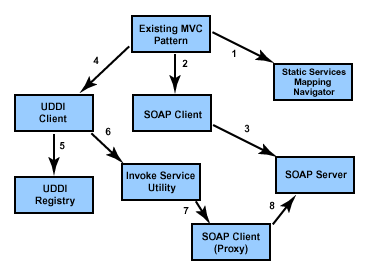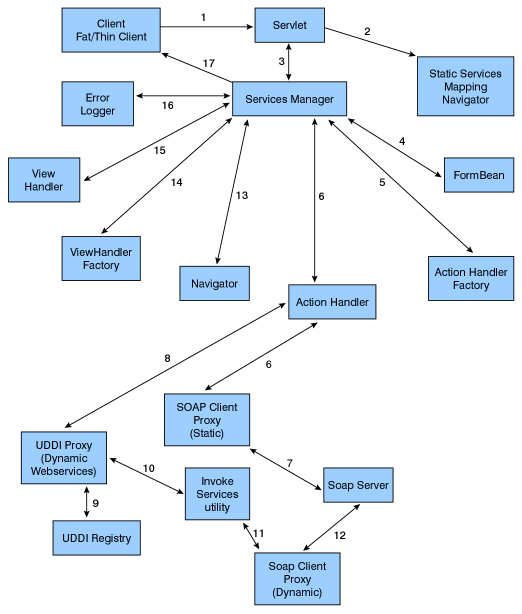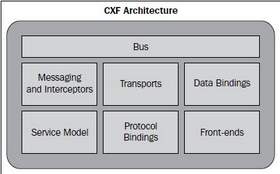Application integration is the biggest challenge today for many enterprises. Building an Enterprise Service Bus (ESB) is probably the quickest and most cost-effective way to address this challenge. In this article, you gain insight on ESBs, and how to model and construct ESB service-oriented architecture frameworks.
Service-Oriented Architecture (SOA) is an approach to defining integration architectures based on the concept of a service. The key components of a SOA include services, dynamic discovery, and messages.
- A service is a callable routine that is made available over a network. A service exposes an interface contract, which defines the behavior of the service and the messages it accepts and returns. The term service is often used interchangeably with the term provider, which specifically denotes the entity that provides the service.
- Interfaces are often published in public registries or directories where they are categorized based on different services offered, just as businesses and their phone numbers are listed in a phone book’s Yellow Pages. Clients (service consumers) can look up a particular service by dynamically querying for services based on various categorization features. This process is referred to as the dynamic discovery of services.
- Service consumers or clients consume services through messages. Because interface contracts are platform- and language-independent, messages are typically constructed using XML documents that conform to an XML schema.
The figure below illustrates the various roles in a SOA.
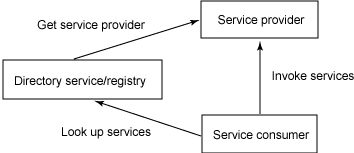
Web services are built on top of open standards and platform-independent protocols. A Web service uses the XML-based Simple Object Access Protocol (SOAP) over HTTP for communication between service providers and consumers. Services are exposed as interfaces defined by Web Service Definition Language (WSDL), whose semantics are defined in XML. Universal Description, Discovery and Integration (UDDI), a language-independent protocol, is used to interact with registries and look for services. All of these features make Web services an excellent choice for developing SOA applications.
When you enable or add Web service interactions that use existing Internet and intranet infrastructure between systems in an architecture, you can create many individual point-to-point integrations, which are difficult to maintain. As organizations move towards service-oriented architectures, which host various deployed services, they require infrastructure service that provides robust communication, intelligent routing, and sophisticated translation and transformation of services.
Application servers provide features like life connection pooling, transaction management, and life cycle management that free the programmer from writing new code for each application. Similarly, an ESB provides common communication and integration services. Because ESBs also use industry standards for most of the services they provide, they facilitate cross-platform interoperability and become the logical choice for companies looking to implement SOA.
The ESB is not a new software product, but a new way to integrate applications, coordinate resources, and manipulate information. Unlike many previous approaches for connecting distributed applications (such as RPC or distributed objects), the ESB pattern enables the connection of software that runs parallel on different platforms, is written in different programming languages, and uses different programming models.
Capabilities of the Enterprise Service Bus
An Enterprise Service Bus exhibits these minimum, or mandatory, capabilities:
- Communication
Supports routing and addressing for at least one messaging style (such as request/response, or publish/subscribe), and at least one transport protocol that is or can be made widely available. This enables location transparency and service substitution, which enables the decoupling of the consumer view of services from their implementation. - Integration
Supports several integration styles or adapters. It enables the provision of services based on these integration capabilities, and decouples technical aspects of service interactions and the integration of services in the enterprise. - Service interaction
Supports an interface definition format and associated messaging model (such as WSDL and SOAP) to allow the decoupling of technical aspects of service interactions. - Management and autonomic
Provides a consistent administration model across a potentially distributed infrastructure, including control over naming, routing, addressing, and transformation capabilities. This enables the management of services in the enterprise.
More advanced ESBs typically offer a number of additional value-added features, including:
- Adapters, to enable connectivity to packaged and custom enterprise applications, as well as to leading technologies.
- Service orchestration engines, to support both long-running (stateful) and short-running (stateless) processes.
- Quality of service and service-level capabilities.
- Presentation services, to enable the creation of personalized portals that aggregate services from multiple sources.
Typical architecture of an Enterprise Service Bus
The architecture of an ESB is centered on a bus. The bus provides message delivery services based on standards such as SOAP, HTTP, and Java Messaging Service (JMS). It is typically designed for high-throughput, guaranteed message delivery to a variety of service producers and consumers. The ESB enables the use of multiple protocols (such as synchronous and asynchronous) and performs transformation and routing of service requests. The ESB enables services to interact with each other based on the quality of service requirements of the individual transactions. It also supports different standards such as SOAP, XML, WSDL, JMS, J2EE, JAX-RPC, and so on.
The following figure illustrates component types that can connect to an ESB:
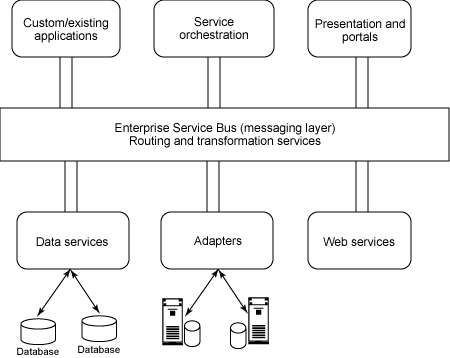
- Custom applications, based on standards like J2EE and Struts, which plug into the ESB to provide a user interface to enterprise services.
- Service orchestration engine, which hosts long running business processes, based on standards like Business Process Execution Language (BPEL).
- Adapters, typically built to the Java Connector Architecture (JCA) specification, enable integration with a wide variety of enterprise applications.
- Presentation and portals enable the creation of personalized portals that aggregate services from multiple sources.
- Data services which provides real time view of data from heterogeneous data sources.
- Web services provides a standard means of connectivity to legacy and proprietary integration technologies.
Today’s fast-paced business world demands the ability to change and adapt rapidly. With an Enterprise Service Bus, you can integrate your business applications and processes quickly and easily as you respond to business challenges and opportunities when they arise.
The ESB pattern can improve operational performance and reduce costs while it simplifies the task of connecting dissimilar applications across a network of different operating systems using open standards such as SOAP, XML, WSDL, JMS, J2EE, JAX-WS, and others.
This article of mine was first published by IBM DeveloperWorks. All rights retained by IBM and the author.

